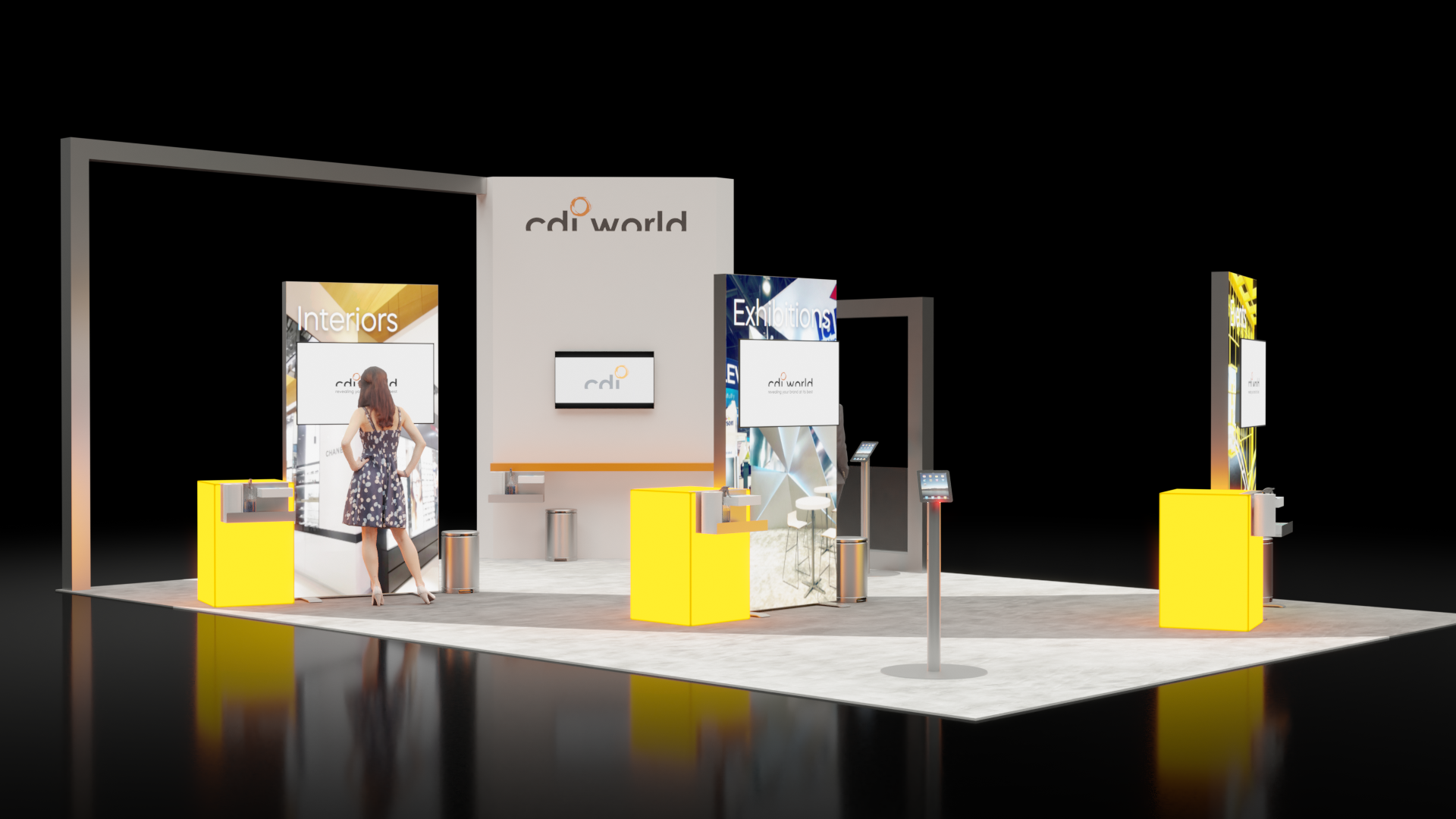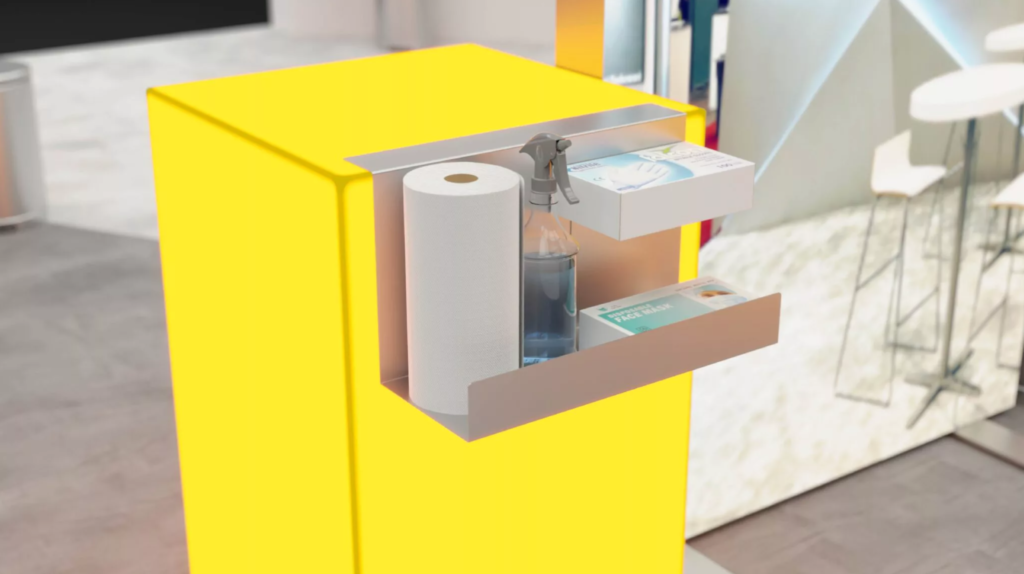


Social distancing and trade show booths might seem utterly incompatible. But smart design and engineering plus some insightful visitor psychology can offer post-lockdown exhibitors a remarkably wide spectrum of options. The big question then, is which to choose…
We could sense the debate happening in board meetings, marketing huddles and their remote teleconferenced versions around the world: Are we still going to exhibit at [insert name of trade show]? And if we do invest in a booth, how on earth are we going to manage social distancing and everything else that comes with it?
With trade shows forming a significant part of our business and having observed the impact of the virus on the global exhibition circuit as it made its inexorable way to our shores, we knew these questions, and many more, were inevitable. We also knew, as exhibition specialists, we had to provide some credible answers.
Further prompted by clients with booths already in the pipeline, we embarked on an intensive design exercise that focused on developing practical solutions to social distancing and other protective measures in trade show environments.
While square footage is always going to be important, we soon found through our dialog with clients that another factor held even more sway – trust.
With problem-solving burnt into our corporate DNA, we were keen to take on the challenge but, at the same time, realized it was unlike anything we’d previously encountered.
We began by identifying the external factors we couldn’t control. For example, conference associations and show organizers were likely to impose their own house rules which in turn would be subject to local health policy. So brands that employed hands-on demos or touch screens, for example, would have to be sure these were still permitted.
And then there was the increasing uncertainty about transport – especially air travel, which for decades has been the only practical option for visitors attending larger international events. Assuming convenient flights were available, would people really want to sit in a confined space with others for hours?
Social distancing and trade show booths might seem incompatible but smart design and psychology can offer exhibitors a wide spectrum of options…
Many prospective exhibitors believed that, until confidence was restored, shows would see reduced attendance. Consequently, some would choose to reduce booth size and save the associated costs. Smaller, Lighter and Simpler would be the new Post-it notes stuck to the top of designers’ screens.
So, Confronted with this shifting set of known unknowns, plus the prospect of a freshly-squeezed budget and a reduced footprint, how does a brand that remains determined to exhibit navigate the Social Distancing v Show Booth scenario? This was our million-dollar question.
It’s all about space, right?
You might suppose that’s the sole starting point for booth designers. After all, there’s only so much of it available in a 10ft x 10ft unit or its multiples. Once you start populating your booth with hosts and visitors, allowing for a minimum 6ft social distance separation, the constraints are obvious.
But while square footage is always going to be important, we soon found through our dialog with clients that another factor held even more sway – trust. When determining the level of protection required in a booth, it can help to ask a stark question: Can I trust the people around me to follow the rules?
The answer you give will almost certainly be nuanced, stretching from Most of the time to I’m not really sure. Despite the impression given by some that the most effective solutions are always universal, the reality is that one size might fit many but it doesn’t fit all. The situation is much more fluid. And that’s why we developed a spectrum of options rather than a hierarchy.
Towards one end of the spectrum the booth structure is minimal and open. Visitors can enter from all sides. The only protective elements are prominent caddies (holding sanitizer, masks, gloves and paper towels), allowing visitors to disinfect their hands and any devices they touch, and the careful spacing of exhibits to assist social distancing.
This is a high trust option. It relies almost completely on individuals policing themselves and following recommendations on hygiene and distancing. The advantage is that the booth design appears largely unmodified, which can be reassuring for some, and additional expenditure is low. The disadvantage is that some visitors may be reluctant to enter a booth with low profile protection.
Some additional control can be provided with stanchions. Widely-used in transport hubs and now in retail to control lines and access, they can offer exhibitors a cost effective although limited way to manage the movement of people through a booth.
Further along to around the mid-point on our spectrum, the booth employs knee-high walls around the perimeter so that entry can be controlled and the number of people kept at a manageable level. Inside, cleaning caddies and carpet inlays enable visitors to practice good hygiene and distancing.
The low walls allow uninterrupted views across the structure, preserving an open feel. The downside is that walls cost more to build and although they allow more control, they don’t provide any physical blocking of airborne particle transmission due to coughing and sneezing, for example. Once visitors are admitted, we rely on their good behavior.
Moving along the spectrum we reach a level of control closer to maximum. The booth is completely enclosed with sheer fabric and acrylic panels providing a full physical barrier. With entry controlled and featuring a one-way system, it’s equipped with standard cleaning caddies and acrylic screens at each of the internal desks to further reduce the risk of airborne transmission.
We found this option split views down the middle – clients either love it for its uncompromising security or hate it for exactly the same reason. People’s emotional response to the structure is key to its acceptance or rejection.
The psychological dimension is present in the finer details too. Take the example of a reception desk with protective screens. If designing from scratch, most designers will want to integrate the screens into the structure as seamlessly and as visually cleanly as possible. For them, less is more and they will fight against bracketing and clutter.
However, there is an argument that the protective trappings made necessary by the pandemic should not only be temporary but look temporary. This view has two intriguing aspects. First, an obviously ‘bolt-on’ fixture draws attention to the fact that the exhibitor has taken special measures to protect people, and conspicuous safety inspires more confidence than the hidden kind. Second, a temporary fixture helps to signal that, one day, the pandemic disruption will be over. It’s a subtle message of hope.
There is a middle way that can reconcile these perspectives and also help to reduce future exhibiting costs. Designers can create booth fixtures such as counters that can accommodate protective screens or similar devices as ‘add-ons’ that can be easily removed or reinstalled without damaging the underlying structure. This non-destructive method means the counter will remain usable for its full design-life, avoiding the need to invest in a post-pandemic replacement.
When we started our design exercise, we supposed that a kind of consensus on protective booth design would emerge – that exhibiting companies, despite their varied nature, would fall neatly into a kind of lockstep after lockdown. We soon altered this preconception.

Every exhibitor wants to do their very best to protect and reassure show visitors at this difficult time, but there’s more than one way to achieve this. By developing a spectrum of options, we hope we’ve informed the debate that so many firms are having. As always, the final choice must be theirs.
The caddy features in every booth configuration. Holding a combination of sanitizer, gloves, masks and paper towels, it can be fixed or mobile. While booth staff can adopt regular cleaning routines, caddies allow visitors to take personal responsibility for their own protection – boosting their confidence that sanitization is adequate.
Talk to us today to find out how we can support you with your exhibit or event, ensuring a memorable and impactful brand experience.
Contact Us